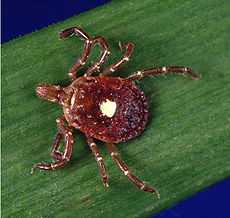Varroa
| Varroa | |
|---|---|
 | |
| Varroa destructor | |
| Scientific classification | |
| Kingdom: | Animalia |
| Phylum: | Arthropoda |
| Class: | Arachnida |
| Subclass: | Acari |
| Order: | Mesostigmata |
| Superfamily: | Dermanyssoidea |
| Family: | Varroidae Delfinado & Baker, 1974 |
| Genus: | Varroa Oudemans, 1904 |
| Species | |
|
See text | |
Varroa is a genus of parasitic mites associated with honey bees, placed in its own family, Varroidae.[1] The genus was named for Marcus Terentius Varro, a Roman scholar who was also a beekeeper. The condition of a honeybee colony being infested with Varroa mites is called varroatosis.
Varroa mites are recognised as the biggest pest to honeybees worldwide, and are believed to be the single largest contributing factor in the modern-day decline of honeybees, due to their ability to transmit diseases such as deformed wing virus to larval and/or pupating bees, resulting in death or severe deformity of the pupae.
History and behavior
Varroa mites feed off the bodily fluids of adult, pupal, and larval honey bees, and may carry viruses that are particularly damaging to the bees (e.g., deformed wings, and IAPV), and accordingly they have been implicated in colony collapse disorder. Research has indicated that alone, neither Varroa mites nor deformed wing virus are particularly deadly, yet together they can pose an incredible risk to colonies.[2][3]
Varroa mites were first discovered in Java about 1904,[4] but are now present on all continents except Australia and since the Isle of Man. They were discovered in the United States in 1987, in New Zealand in 2000,[5] and in the United Kingdom in 1992 (Devon).
Bee-breeding efforts to develop resistance against Varroa are ongoing. The USDA has developed a line of bees which uses Varroa-sensitive hygiene to remove reproductive mites. This line is now being distributed to beekeepers to be used as part of their integrated pest management programs.
Species
The genus Varroa contains these species:[1]
- Varroa destructor Anderson & Trueman, 2000 is a virulent parasite that infests its natural host, Apis cerana (Asian honey bees), on mainland Asia and also Apis mellifera (western honey bee) worldwide.
- Varroa jacobsoni Oudemans, 1904 is a relatively benign parasite of Apis cerana.
- Varroa rindereri de Guzman & Delfinado-Baker, 1996
- Varroa sinhai (Delfinado & Baker, 1974)
- Varroa wongsirii (Lekprayoon & Tangkanasing, 1991)
References
- ↑ 1.0 1.1 Joel Hallan. "Varroidae Delfinado & Baker, 1974". Texas A&M University. Retrieved June 13, 2010.
- ↑ http://www.livescience.com/20815-honeybee-collapse-mite-virus.html
- ↑ http://www.livescience.com/271-bees-wiped-cascade-deadly-events.html
- ↑ D. L. Anderson & J. W. H. Trueman (2000). "Varroa jacobsoni (Acari: Varroidae) is more than one species". Experimental and Applied Acarology 24 (3): 165–189. doi:10.1023/A:1006456720416. PMID 11108385.
- ↑ Zhi-Qian Zhang (2000). "Notes on Varroa destructor (Acari: Varroidae) parasitic on honeybees in New Zealand" (PDF). Systematic & Applied Acarology. Special Publications 5: 9–14.
External links
| |||||||||||||||||||||||||||||||||||||||||||||||||||||||||||||
